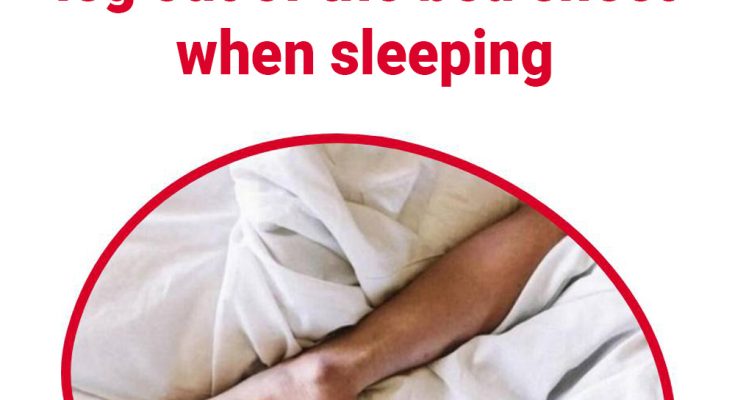Everyone has their own peculiar bedtime habits — a favorite pillow, a specific side of the bed, a need for total darkness, or the TV humming softly in the background. But one habit seems almost universal: sticking one leg out from under the blanket. It’s such a simple, almost unconscious move, yet it happens across cultures, climates, and ages. The funny thing? Science says there’s a real reason behind it — and it’s not just comfort.
It’s biology.
According to sleep experts, the act of sliding one foot or leg outside the sheets is a built-in cooling mechanism that helps your body regulate its temperature and transition into deeper, more restful sleep.
María José Martínez, coordinator of the Chronobiology Group at the Spanish Sleep Society, explains that our bodies have a delicate relationship with temperature. To fall asleep, we need to cool down internally by roughly one to two degrees Fahrenheit. “Falling asleep requires the body to lose heat,” Martínez says. “We do this through vasodilation — when blood vessels in the hands and feet widen, allowing heat to escape.”
That’s where your uncovered leg comes in.
When you stick your leg out from under the covers, it exposes more skin to the cooler air, which helps blood flow near the surface release excess heat. This small drop in core body temperature signals to the brain that it’s time to power down and drift into sleep.
This thermoregulation process — your body’s ability to balance heat production and loss — is one of the most critical factors in healthy sleep. The human body is a finely tuned machine that runs on circadian rhythms, and temperature plays a big role in setting those internal clocks. During the day, your temperature naturally rises to keep you alert and active. At night, it drops as your metabolism slows and melatonin (the “sleep hormone”) kicks in.
Exposing one limb to the open air gives your body a quick, natural way to reach that cooler nighttime temperature faster. It’s like hitting the “sleep mode” switch.
You can see this in babies too. Their bodies are masters at thermoregulation. When infants get ready to sleep, their hands, feet, and ears often turn warm — it’s their bodies flushing out heat so their cores can cool down. Adults work the same way, though we usually need help creating the right conditions, especially in modern bedrooms that are too warm or packed with heavy bedding.
So, when you instinctively slide that foot out, you’re not being quirky — you’re helping your body do its job.
But temperature is just one piece of the sleep puzzle. For truly restorative rest, experts emphasize building a consistent set of habits that align with how your body and brain naturally function.
The first rule: stick to a routine. Go to bed and wake up at the same times each day, even on weekends. This consistency reinforces your circadian rhythm — the body’s built-in 24-hour clock — making it easier to fall asleep and wake up without feeling groggy.
Second, aim for seven to eight hours of sleep each night. Too little sleep over time doesn’t just make you tired; it impairs memory, weakens the immune system, slows metabolism, and raises stress hormones.
Third, keep your sleep environment cool, dark, and quiet. Most experts agree that the ideal room temperature for sleep sits between 60 and 67 degrees Fahrenheit (about 16–19°C). Cooler air helps your body drop its core temperature faster — which, again, might explain why that exposed leg feels so good.
If you struggle to sleep, here are some science-backed adjustments that can make a major difference:
- Avoid heavy meals and alcohol before bed. Digesting large amounts of food raises your body temperature and heart rate — the opposite of what you want at bedtime. Alcohol may make you drowsy at first, but it disrupts the deep stages of sleep.
- Limit long naps. A quick 20–30-minute nap can be refreshing, but longer daytime sleep confuses your body clock, making it harder to fall asleep at night.
- Move your body — but not too late. Exercise during the day improves sleep quality, but intense workouts close to bedtime can delay sleep because they elevate core temperature and adrenaline levels.
- Create a calm mind before bed. Worrying about the day or scrolling on your phone floods your brain with stimulation and blue light, both of which tell your body it’s still “daytime.” Try writing down your thoughts, meditating, or reading something light instead.
And perhaps the simplest — yet most effective — tip: let your body breathe.
Modern bedding, especially thick duvets and synthetic materials, traps heat. Natural fabrics like cotton, bamboo, or linen allow airflow, keeping you cooler. Pairing that with a foot peeking out from under the sheets gives your body a way to dump excess heat without waking you up. It’s an effortless act of thermoregulation — one that’s been quietly helping humans sleep better for centuries.
Interestingly, research has also shown that temperature regulation plays a role in the timing of sleep cycles. When your body cools, blood flow to the brain changes, supporting the transition into slow-wave (deep) sleep and REM stages — the two phases responsible for physical recovery and memory processing. The simple act of cooling down faster, even by a fraction, can mean more time in these restorative phases and fewer middle-of-the-night awakenings.
So that little move — foot outside the blanket, ankle kissing the cool night air — is your body’s built-in sleep aid.
Some scientists even argue that designing “thermoregulatory” bedding could transform how we sleep. Future mattresses and blankets may come with climate-control technology, automatically adjusting temperature zones for the feet and hands. But for now, your leg outside the sheets does the job perfectly — no gadgets required.
In the end, sleep isn’t about complex routines or expensive products. It’s about honoring the rhythms your body already knows. Just as you naturally feel hungry at certain times or crave sunlight after days indoors, your body knows when to release heat and when to hold onto it.
That’s what makes this small gesture — one bare leg peeking out of the sheets — so powerful. It’s an instinct, a whisper from your biology saying, “I’m ready to rest.”
So tonight, when you find yourself tossing and turning, remember: sometimes the best sleep hack isn’t in a pill, a gadget, or a meditation app. It’s already in your body’s wiring — one simple, instinctive act that balances comfort and science.
Stick that leg out. Let the night air do its work. And sleep like your body was built to.



